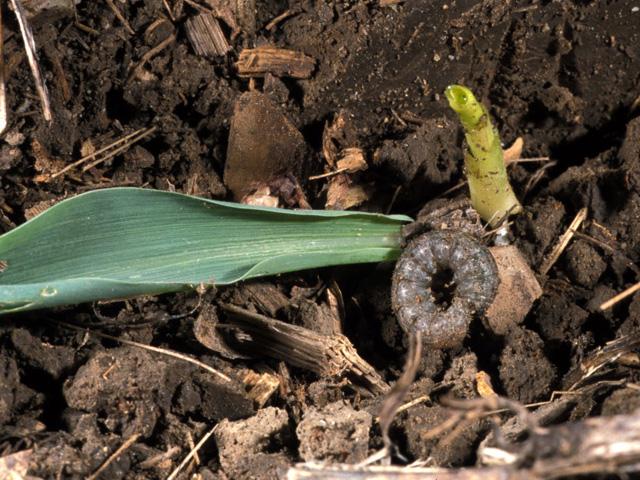Black Cutworm Alert
Watch Out for Cutworms in Young Crop Fields
ROCKVILLE, Md. (DTN) -- How much corn could a cutworm cut if a cutworm could cut corn?
Growers across the Midwest and Eastern Corn Belt will find out, as temperatures finally start climbing high enough for black cutworms to emerge from the eggs laid in the soil earlier this spring.
Entomologists from Indiana, Kentucky, Maryland, Minnesota, Ohio, Pennsylvania and Wisconsin are advising growers to keep an eye out for the black cutworm in their fields, particularly for young, slowly emerging corn stands.
Cutworm moths are snowbirds -- they don't much care for Midwest winters and spend the coldest months in southern states, all the way down to the Gulf. But each spring, they flutter their way up and lay eggs, with a fondness for fields with weeds and cover crops.
The emerging black cutworm's larvae often migrate into emerging corn, and as soybean planting inches earlier each year, also soybean fields. They can "cut" young plants off at the base, destroying the growing point and causing serious stand issues. The damage they inflict depends on their size and the crop's stage of development, explained John Obermeyer, integrated pest management specialist for Purdue University, in a newsletter alert on the pests.
P[L1] D[0x0] M[300x250] OOP[F] ADUNIT[] T[]
Early planted, fast-emerging corn can often grow quickly enough to outpace cutworm emergence and be large enough to survive the pest's feeding, Obermeyer noted. But that hasn't been the case for some growers this spring, with cool weather and drought slowing crop emergence in many parts of the Corn Belt.
See more here: https://www.dtnpf.com/…
Insecticide seed treatments can also briefly protect corn seedlings from cutworms when they first emerge and are relatively small. "It is important to note that this is not true with mid-to-later developed larvae," Obermeyer wrote. "[For example] black cutworm initially feeding and developing on weeds/cover crops and then shifting to emerging corn."
Corn plants are most vulnerable to feeding damage from cutworms and armyworms at the V2 to V4 stage, said University of Illinois Extension entomologist Nick Seiter. As they move into the V5 through V7 stages, the plants become large and robust enough to recover from feeding.
Don't rely on Bt traits to completely protect your cornfields, Seiter added. While some Bt traits supply suppression of these pests, they cannot necessarily withstand a heavy infestation. See more on Bt traits and their target pests here: https://www.texasinsects.org/…
See more on how to scout for black cutworm here: https://extension.entm.purdue.edu/…
For more details on the less common phenomenon of soybean damage from cutworms, see this Iowa State article: https://crops.extension.iastate.edu/…
You can read more from Obermeyer here: https://extension.entm.purdue.edu/…
Editor's Note: This story has been updated from a DTN story published last April.
See it here: https://www.dtnpf.com/…
Emily Unglesbee can be reached at: Emily.unglesbee@dtn.com
Follow her on Twitter @Emily_Unglesbee
(c) Copyright 2021 DTN, LLC. All rights reserved.






